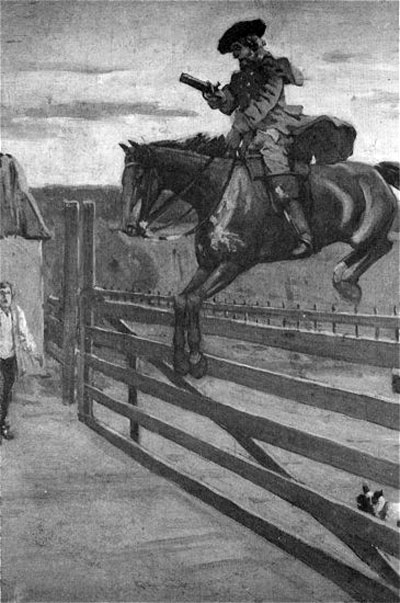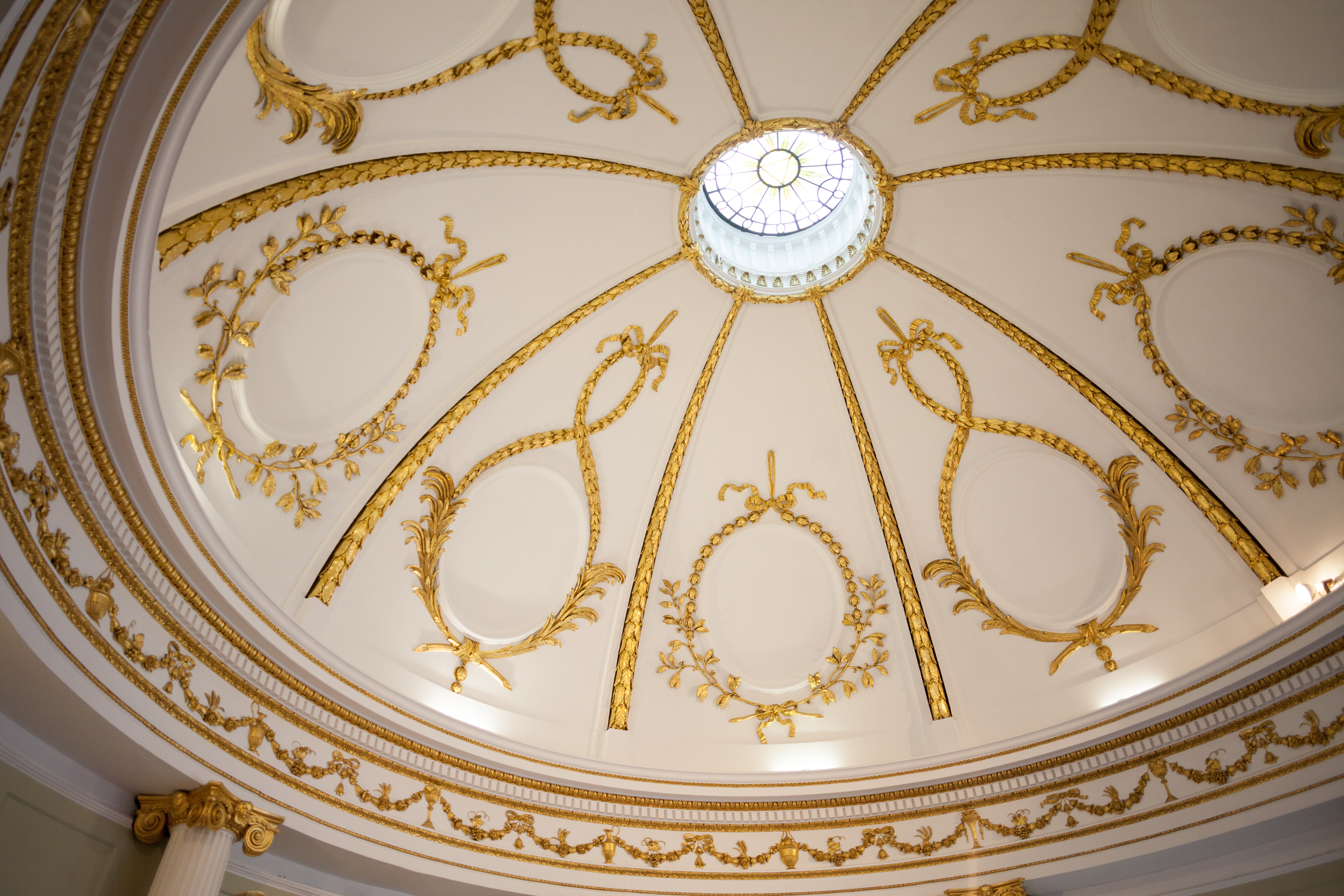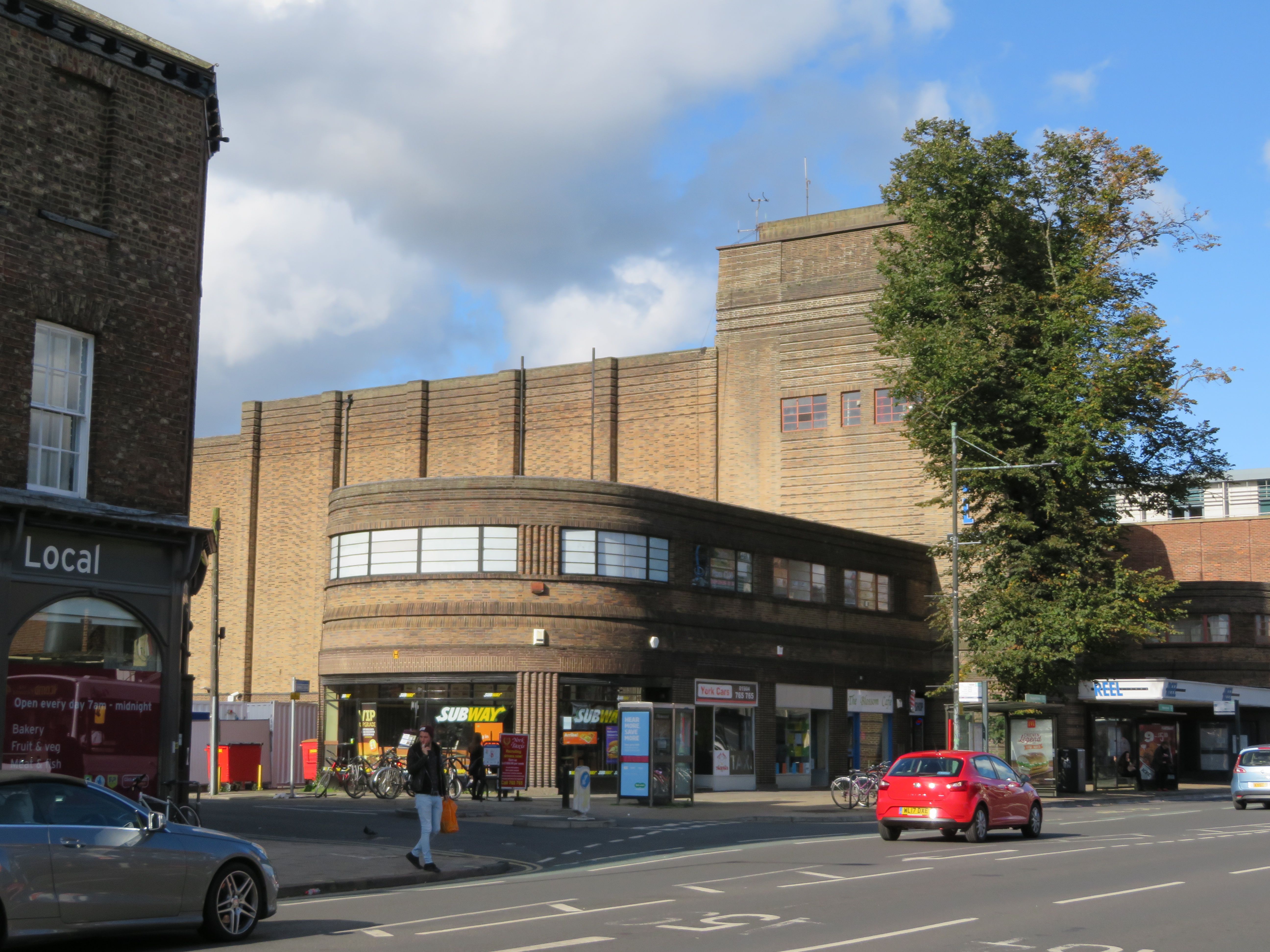|
Blossom Street
Blossom Street is a road in York, in England, immediately west of the city centre. History The street has been the main route leading south and west from York from the Roman Eboracum era onwards; the Roman roads to Calcaria (now Tadcaster) and Isurium Brigantum (now Aldborough, North Yorkshire) ran parallel to the modern road, to the rear of the buildings on its north-western side. While the area was initially agricultural, it was later used as a rubbish dump, and then as a cemetery. Remains of several tombs have been found. By the 5th-century, it appears to have been used as agricultural land once more. The street was first recorded in the early-13th century, as Ploxswaingate, named for the ploughswains living in the area, and by 1282, 29 plots along the street had already been built upon. Unlike other streets in Mediaeval York, it was extremely wide, and as a result, a horse and cattle market was held on it. By 1639, there were 68 houses on the street, and although there ... [...More Info...] [...Related Items...] OR: [Wikipedia] [Google] [Baidu] |
York
York is a cathedral city with Roman origins, sited at the confluence of the rivers Ouse and Foss in North Yorkshire, England. It is the historic county town of Yorkshire. The city has many historic buildings and other structures, such as a minster, castle, and city walls. It is the largest settlement and the administrative centre of the wider City of York district. The city was founded under the name of Eboracum in 71 AD. It then became the capital of the Roman province of Britannia Inferior, and later of the kingdoms of Deira, Northumbria, and Scandinavian York. In the Middle Ages, it became the northern England ecclesiastical province's centre, and grew as a wool-trading centre. In the 19th century, it became a major railway network hub and confectionery manufacturing centre. During the Second World War, part of the Baedeker Blitz bombed the city; it was less affected by the war than other northern cities, with several historic buildings being gutted and restore ... [...More Info...] [...Related Items...] OR: [Wikipedia] [Google] [Baidu] |
Knavesmire
The Knavesmire is one of a number of large, marshy undeveloped areas within the city of York in North Yorkshire, England, which are collectively known as '' Strays''. Knavesmire, together with Hob Moor, comprises Micklegate Stray. It has been suggested that the name 'Knavesmire' may share a derivation with Knaresborough—Cenward's mire. History Situated in the south-west of the city, some distance outside the historic walls, Knavesmire's low-lying position makes it liable to severe flooding in times of heavy rain. As a consequence, it remained undeveloped as the city expanded around it. The Knavesmire was the site of York Golf course for many years. During the Second World War, parts of the Knavesmire were farmed, while other parts were used for military purposes including an anti-aircraft battery and a prisoner of war transit camp which was located near the grandstand. Knavesmire was also the site of Knavesmire Secondary School, which then became one of the campuses of ... [...More Info...] [...Related Items...] OR: [Wikipedia] [Google] [Baidu] |
JD Wetherspoon
J D Wetherspoon plc (branded variously as Wetherspoon or Wetherspoons, and colloquially known as Spoons) is a pub company operating in the United Kingdom and Ireland. The company was founded in 1979 by Tim Martin and is based in Watford. It operates the sub-brand of Lloyds No.1 bars, and around 50 Wetherspoon hotels. Wetherspoon is known for converting unconventional premises, such as former cinemas and banks, into pubs. The company is publicly listed on the London Stock Exchange and is a constituent of the FTSE 250 Index. History Tim Martin opened his first pub in 1979 in Colney Hatch Lane in Muswell Hill, London. Many of the other early Wetherspoon pubs were also in the western part of Haringey. The name of the business originates from JD, a character in ''The Dukes of Hazzard'', and Wetherspoon, the surname of one of Martin's teachers in New Zealand, who had told him that he would not amount to anything. During the 1990s, Wetherspoons began a policy of routinely closin ... [...More Info...] [...Related Items...] OR: [Wikipedia] [Google] [Baidu] |
Everyman Cinemas
Everyman Media Group plc (known as Everyman Cinemas) is a cinema company based in London, England. The company was founded in 2000, when entrepreneur Daniel Broch bought the original Everyman Cinema in Hampstead, London, which dated to 1933, which before then was a theatre. Broch led the growth of the company with the acquisition in 2008 of Screen Cinemas to add more locations. This coincided with Broch selling a majority stake in the enlarged company, though he remains a shareholder. Following the acquisition, the group has refurbished or plans to refurbish a number of cinemas. Those already refurbished include Walton, Belsize Park, Baker Street, and The Screen On The Green in Islington. Everyman's cinemas have one to five screens, a small number of which offer 3D. Everyman Cinemas offer a programme of films and special events, including the Metropolitan Opera from New York and the National Theatre (in selected cinemas), live Q&As, film festivals and seasons. The venues eac ... [...More Info...] [...Related Items...] OR: [Wikipedia] [Google] [Baidu] |
Bay Horse, York
The Bay Horse is a pub on Blossom Street, immediately west of the city centre of York, in England. The core of the building was constructed in the late-17th century, after the Siege of York, as a small farmhouse. It was first recorded as an inn in 1748, around which time it was raised to three storeys, and extended from an L-plan to a square plan. It is now a three bay building, built of brick, with a rendered front which has a parapet disguising the tiled roof. The staircase dates from the mid-18th century, and there are some fittings from the Regency period. By 1798, the inn was named the "Bay Horse". This name is believed to refer to the horse Bay Malton, who won a major race nearby, at York Racecourse. Some of the windows were altered in the 19th-century. From 1862 until 1874, the pub and its brewhouse were owned by the Institute of the Blessed Virgin Mary. By 1969, the pub was owned by John Smith's Brewery John Smith's Brewery in Tadcaster, North Yorkshire, En ... [...More Info...] [...Related Items...] OR: [Wikipedia] [Google] [Baidu] |
Bar Convent
The Convent of the Institute of the Blessed Virgin at Micklegate Bar, York, better known as The Bar Convent Living Heritage Centre, is the oldest surviving Catholic convent in England, established in 1686. The laws of England at this time prohibited the foundation of Catholic convents and as a result of this, the convent was both established and operated in secret. Frances Bedingfeld, a member of the Sisters of Loreto (also known as the IBVM), signed the deeds for the land the convent was to be built upon on 5 November 1686 under the alias Frances Long. Today, the Bar Convent is a popular York destination for tourists and offers bed and breakfast accommodation, meeting rooms, a gift shop, café and museum exhibition about the Convent's history. History Origin and early years The creation of the Convent was inspired, at least in part by Sir Thomas Gascoigne, a fervent Catholic who declared "we must have a school for our daughters". Gascoigne even went as far as providing a g ... [...More Info...] [...Related Items...] OR: [Wikipedia] [Google] [Baidu] |
Harry Weedon
Harold William "Harry" Weedon (1887 – 17 June 1970) was a British architect. Although he designed a large number of buildings during a long career, he is best known for his role overseeing the Art Deco designs of the Odeon Cinemas for Oscar Deutsch in the 1930s. Influenced by the work of Erich Mendelsohn and Hans Poelzig – the Odeons "taught Britain to love modern architecture" and form "a body of work which, with London Underground stations, denotes the Thirties like nothing else". Life Education and early career Weedon was born in Handsworth, Birmingham, the son of a commercial traveller, and educated at King Edward's School in the city. He studied architecture at the Birmingham School of Art from 1904, before being articled to the architectural practice of Robert Atkinson. In 1912 at the age of 24 he was made an associate of the Royal Institute of British Architects and went into partnership with Harold S. Scott, with whom he designed a cinema in Birchfield, completed ... [...More Info...] [...Related Items...] OR: [Wikipedia] [Google] [Baidu] |
Odeon Cinema, York
The Odeon Cinema is a Grade II listed In the United Kingdom, a listed building or listed structure is one that has been placed on one of the four statutory lists maintained by Historic England in England, Historic Environment Scotland in Scotland, in Wales, and the Northern Irel ... building immediately west of the city centre of York, in England. The Odeon Cinemas chain was keen to build a cinema in York, but it could not gain permission to construct a large building within the York city walls. Initial plans were toned down, and the resulting building is almost entirely of brown brick, with none of the tiles which often feature in Harry Weedon's work. Following these changes, permission was granted to build on Blossom Street, just outside the walls. The building opened as an Odeon Cinema on 1 February 1937. It was designed by Harry Weedon, with the assistance of Robert Bullivant, and with interiors attributed to Lily Deutsch. The construction cost £40,500. On opening, ... [...More Info...] [...Related Items...] OR: [Wikipedia] [Google] [Baidu] |
Windmill Inn
The Windmill Inn is a pub on Blossom Street, immediately west of the city centre of York, in England. The oldest part of the pub is on the corner of Blossom Street and Queen Street, although until 1911 another building separated it from Queen Street. Dating from the late-17th century, it was constructed as two cottages and was probably part of reconstruction in the area following the Siege of York. This section is brick built, but with timber framed internal partitions. It contains early chimney breasts and a mid-18th century staircase, and the bay windows at the front date from 1785 or earlier, though they have been heavily altered. The building is first recorded as the "Windmill Inn" in a deed of 1735. At the time, it was owned by the Lee family, who had previously leased a windmill near the top of The Mount. Soon after the purchase, it was extended south along Blossom Street, and then in 1820 a further extension was added to the south, incorporating a carriage arch into ... [...More Info...] [...Related Items...] OR: [Wikipedia] [Google] [Baidu] |
Micklegate Bar
York has, since Roman times, been defended by walls of one form or another. To this day, substantial portions of the walls remain, and York has more miles of intact wall than any other city in England. They are known variously as York City Walls, the Bar Walls and the Roman walls (though this last is a misnomer as very little of the extant stonework is of Roman origin, and the course of the wall has been substantially altered since Roman times). The walls are generally 13 feet (4m) high and 6 feet (1.8m) wide. History Roman walls The original walls were built around 71 AD, when the Romans erected a fort (castra) occupying about 50 acres or 21.5 hectares near the banks of the River Ouse. The rectangle of walls was built as part of the fort's defences. The foundations and the line of about half of these Roman walls form part of the existing walls, as follows: *a section (the west corner, including the Multangular Tower) in the Museum Gardens *the north-west and north-ea ... [...More Info...] [...Related Items...] OR: [Wikipedia] [Google] [Baidu] |
Siege Of York
The siege of York in 1644 was a prolonged contest for York during the First English Civil War, between the Scottish Covenanter army and the Parliamentarian armies of the Northern Association and Eastern Association, and the Royalist Army under the Marquess of Newcastle. It lasted from 22 April until 1 July when the city was relieved by Prince Rupert of the Rhine. Rupert and Newcastle were defeated the next day at the decisive Battle of Marston Moor, and the siege resumed until the city was surrendered on easy terms on 16 July. Campaign Early years of the Civil War During the 17th century, York was often referred to as the "capital of the north" and sometimes as the "second city in England" (although Bristol had a larger population). It had great prestige as the seat of the Archbishop of York, and as the centre of much of the region's trade. When civil war broke out in 1642, the Royalists in Yorkshire were briefly besieged in the city, until the Earl of Newcastle ... [...More Info...] [...Related Items...] OR: [Wikipedia] [Google] [Baidu] |
Micklegate
Micklegate is a street in the City of York, England. The name means "Great Street", "gate" coming from the Old Norse ''gata'', or street. Micklegate is described by York City Council as "one of the most handsome streets in Yorkshire", and was described by Nikolaus Pevsner as "...without any doubt the most architecturally rewarding street in York". There are three Medieval churches on the street, and a total of four Grade I listed buildings, with the majority of buildings being three- or four-storey Georgian structures. The name Micklegate is sometimes applied to a slightly broader area, including the side streets Toft Green, Priory Street, Trinity Lane and St Martin's Lane. There is also a ward of Micklegate, used for elections to the City Council, which covers a much larger area, spreading well beyond the city walls. Geography The street runs east from the York city walls at Micklegate Bar, long the main southern entrance to the city, continuing the route of Blossom Street. ... [...More Info...] [...Related Items...] OR: [Wikipedia] [Google] [Baidu] |









